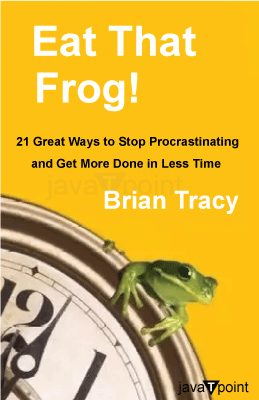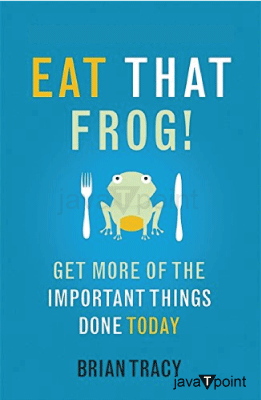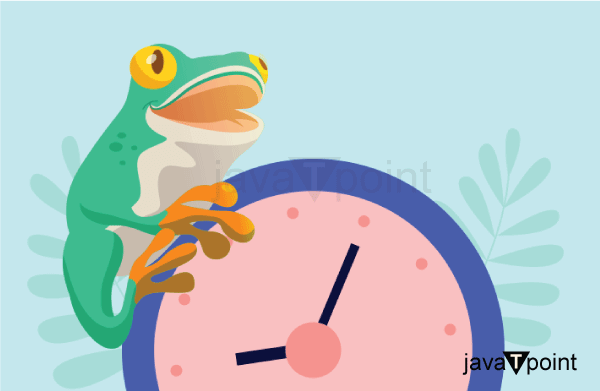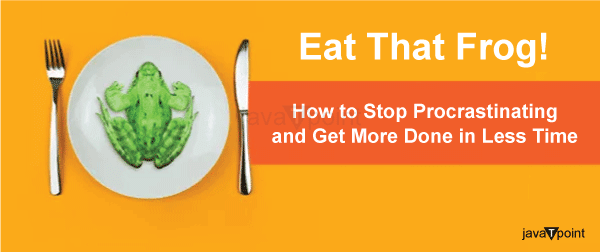Eat That Frog! by Brian Tracy SummaryThe main focus of Brian Tracy's book "Eat That Frog!" is overcoming Procrastination and boosting productivity, which is outlined in the book's introduction. Tracy highlights the detrimental effects of Procrastination on personal and professional performance, emphasizing how it impedes development, adds stress, and reduces achievement. The author introduces the idea of "eating the frog," which implies doing the day's hardest and most important activity first. Tracy contends that by doing this, people may overcome Procrastination and form the habit of acting, which boosts productivity and success. 
The significance of establishing clear priorities and goals is also covered in the introduction. Tracy stresses the need for a distinct sense of direction and purpose to make wise judgments and pay attention to the important things. He presents the idea of priority to increase productivity and explains why it is so important. Additionally, the introduction explores the psychological obstacles to Procrastination, such as perfectionism, failure fear, and a lack of enthusiasm. Tracy offers advice on how to get through these obstacles by building a proactive mindset and creating plans for quick action. The introduction's conclusion highlights the benefits of overcoming Procrastination and boosting productivity. Tracy emphasizes that readers can achieve their goals, experience personal and professional growth, and build a more happy and successful life by learning the principles contained in the book. Overall, Eat That Frog's introduction establishes the foundation for the book's primary ideas by outlining the issue of Procrastination, the significance of productivity, and the promise of change through the methods and tactics covered in the following chapters. The Eating That Frog Rule"Eating that frog" is key in Brian Tracy's book "Eat That Frog!" for overcoming Procrastination and increasing productivity. Tracy utilizes the frog image to symbolize the most difficult and crucial job on a person's to-do list. This task should be started first thing in the morning, before any other less important or simpler tasks, goes the theory. Tracy contends that finishing the most important activity in the morning gives people a sense of success and momentum that spreads to the next chores. This method aids in overcoming the propensity to put off or become distracted by less important tasks, which can result in a vicious cycle of unproductive behaviour. 
Tracy says that people might break the cycle of Procrastination and develop the habit of acting right away by completing the most crucial tasks first. This strategy ensures that crucial chores are not routinely put off, boosting productivity and advancing goals. Tracy recommends that readers list their most important chores and rank them in order of importance and urgency to put the eating that frog approach into practice. He emphasizes how crucial it is to plan and organize projects, divide them into smaller, more manageable phases, and set aside time to work on them. Tracy also encourages readers to fight the urge to put off doing challenging or unpleasant things in favor of developing the discipline and focus necessary to face them head-on. People can lessen tension and relieve mental energy for other things during the day by tackling difficult jobs early. The idea of "eating that frog" is an effective method for reducing Procrastination and boosting productivity. Tracy's method emphasizes the significance of managing one's time and priorities, and it provides a useful framework for getting more done by concentrating on the initiatives that matter. Setting Specific Priorities and GoalsClear goals and priorities are underlined as a crucial first step in achieving success and boosting productivity in Brian Tracy's book "Eat That Frog!" Tracy contends that people are more likely to become distracted by little chores and succumb to Procrastination if they lack a clear sense of purpose and direction. According to Tracy, having specific goals gives people a direction for their actions, helping them to stay motivated and focused. Clear objectives serve as a compass, assisting people in making choices and efficiently allocating their time and resources. 
Tracy suggests using the SMART goal-setting framework to create specific targets. Specific, Measurable, Achievable, Relevant, and Time-bound are all acronyms for SMART goals. People can construct well-defined targets that are achievable and have a clear schedule for fulfilment by setting goals that fit these characteristics. Prioritization is essential for efficient time management, productivity, and goal-setting. Tracy emphasizes the significance of classifying tasks according to relevance and urgency. People can direct their time and energy toward the activities that will have the biggest effects by separating the essential jobs from the less important ones. Tracy advises employing strategies like making a to-do list, classifying jobs according to their priority, and concentrating on high-priority issues. He also stresses the significance of periodically reviewing and reevaluating priorities to ensure they align with evolving conditions and objectives. People can better understand what they need to accomplish and align their actions by creating clear goals and priorities. This clarity aids in overcoming Procrastination because people are better able to prioritize their duties and avoid feeling overwhelmed or diverted by less important pursuits. Establishing clear priorities and goals is a key step in boosting productivity. It gives people a feeling of purpose, facilitates wise decision-making, and guarantees their time and energy are put toward things that advance their long-term success. Organization and Planning for Maximum ProductivityPlanning and organization are crucial components for boosting productivity in Brian Tracy's book "Eat That Frog!" Tracy emphasizes that good planning and organization enable people to maximize their time, reduce waste of effort, and produce better outcomes. Tracy urges readers to approach planning proactively by giving their objectives, obligations, and due dates some thought. He stresses the importance of setting aside enough time for planning because it will ultimately save time and effort. The following are essential components of the organization and planning for best productivity: 1. Time BlockingTracy advises setting up specified periods for various duties and hobbies. By establishing allocated time, people can reduce distractions and concentrate on key uninterrupted tasks. 2. PrioritizationTracy suggests that people order their work according to priority and urgency, building on the idea of creating clear goals and priorities. Individuals can ensure that their efforts are focused on projects that will influence their goals most by concentrating on high-priority activities. 3. Making to-do ListsTracy highlights the need to make daily lists of things that need to get done. These lists serve as visual reminders and give the day structure and direction. 4. Organizing Jobs into Manageable StepsComplicated or large projects can frequently feel daunting. Tracy advises breaking them down into more manageable, smaller steps. This method makes the duties less intimidating, and the necessary activities are more clearly understood. 5. Setting DeadlinesSetting deadlines for work promotes accountability and a sense of urgency. Tracy recommends establishing reasonable deadlines and keeping them to retain concentration and productivity. 
6. Keeping Distractions to a MinimumTracy advises readers to recognize and eliminate any distractions hindering productivity. This can entail disabling notifications, designating particular times for accessing social media or email, or setting up a private workspace with few interruptions. 7. Reviewing and Modifying PlanIt's critical to regularly evaluate and modify plans to account for shifting priorities and conditions. To ensure that plans and tasks continue to align with goals and objectives, Tracy advises doing periodic evaluations. People can maximize their productivity and achieve better outcomes in their personal and professional life by putting smart planning and organization tactics into practice. These methods support people in making the most of their time, staying focused, and working productively towards their objectives. The Power of DecisionThe ability to make decisions and carry them out successfully is discussed as a crucial element in obtaining success and maximizing productivity in "Eat That Frog!" by Brian Tracy. Tracy highlights that overcoming Procrastination and achieving one's goals requires the capacity to make decisions and take action. Tracy highlights the following elements of decision-making and implementation: 1. Clarity and ConfidenceConfidence and clarity are essential for making good decisions. One must be clear about their objectives, top priorities, and intended outcomes. Tracy advises readers to clearly define their goals to create a strong foundation for decision-making. Furthermore, taking decisive action requires one to have confidence in their choices. 2. Time-Sensitive DecisionsDelay and indecision can result in lost time and opportunity. Tracy emphasizes the significance of making decisions promptly. Individuals can prevent analysis paralysis and keep moving forward by setting decision timelines. 3. Analysing Rewards and RisksEvery choice has some level of risk. Tracy suggests that people thoroughly consider their options' potential dangers and benefits. Making informed decisions and taking reasonable risks are made easier thanks to this examination. 4. Information GatheringIt's important to obtain pertinent data and consider various viewpoints when making decisions. Before making crucial decisions, Tracy advises researching, consulting with experts, and reviewing the information. 5. Taking ActionIn the decision-making process, implementation is a critical phase. Tracy highlights the need to act right away after making a decision. Even the best judgments can have less impact if completed on time. Quick action promotes productivity and advancement toward objectives. 6. Adapting and AdjustingNot all choices will result in the desired results. Tracy emphasizes being willing to modify and adapt decisions as situations change. Individuals can manage difficulties efficiently if they are adaptable and willing to modify course. 7. Commitment and AccountabilityAfter making a decision, Tracy emphasizes the need for commitment and accountability. When held accountable for their decisions, individuals are encouraged to follow through and take the necessary actions for successful implementation. People can eliminate their indecision and confidently advance toward their goals by comprehending the importance of decision-making and carrying it through. Readers are encouraged by Tracy's ideas to embrace decision-making as a driver for advancement and productivity. Taking the Initiative and Overcoming ProcrastinationIn Brian Tracy's book "Eat That Frog!" the main theme is overcoming Procrastination and acting. Tracy is aware that Procrastination is a problem that frequently arises, impeding productivity and keeping people from realizing their full potential. To assist readers in overcoming Procrastination and forming the habit of acting right away, he provides them with useful tactics and techniques. The following are the main ideas and strategies Tracy covered in connection to getting over Procrastination and acting: 1. Understanding the Cost of ProcrastinationTracy focuses on the detrimental effects of procrastinating on personal and professional success. He highlights the negative effects of postponing crucial activities, such as increased stress, lost chances, and decreased productivity. 2. Recognizing the Causes of ProcrastinationThe fear of failure, perfectionism, a lack of desire, and a lack of clarity are just a few of the psychological causes Tracy examines. People can more successfully address them if they know the root reasons. 3. Applying the "frog" PrincipleTracy presents the idea of "eating the frog," which refers to starting with the trickiest and most crucial activity. People can develop momentum, feel a sense of accomplishment, and overcome the propensity to procrastinate by concentrating on and finishing the most important activity first thing in the morning. 4. Organizing Jobs into Manageable StepsProcrastination is often caused by large or overwhelming projects. Tracy suggests breaking up difficult activities into more manageable chunks. With this method, things become less daunting, and people are more likely to take action. 5. Creating Deadlines and AccountabilitySetting deadlines for activities fosters accountability while also fostering a sense of urgency. Tracy advises setting deadlines and committing to them, either on an individual basis or with the help of others who can hold people accountable. 6. Managing Time EffectivelyEffective time management is essential in the fight against Procrastination. Tracy provides advice on managing time better and staying focused on action, including time blocking, prioritizing, and reducing distractions. 
7. Learning Self-DisciplineSelf-discipline and discipline are necessary to overcome Procrastination. Tracy advises developing these traits by continually taking baby moves in the right direction and gaining momentum over time. 8. Embracing the 'do it now' MindsetTracy advises her readers to adopt a proactive mindset of "do it now" rather than procrastinating things. Individuals can avoid chores building up and becoming overwhelming by acting swiftly when they emerge. 9. Celebrating ProgressProgress should be celebrated, Tracy advises, as should any victories along the road. Recognizing and praising oneself for taking action can support the development of productive habits and encourage ongoing effort. People can overcome Procrastination and form the habit of acting by practicing these ideas and developing a proactive mentality. Tracy's advice provides doable methods to interrupt the cycle of delays and increase output in both personal and professional undertakings. Time Management Strategies and TechniquesTime management methods and strategies are examined as vital resources for maximizing output and success in Brian Tracy's book "Eat That Frog!" Tracy provides helpful strategies to assist people in properly managing their time, remaining focused, and achieving their objectives. The following are effective time management strategies covered in the book: 1. Prioritizing and SchedulingPrioritization is a fundamental time management method. It involves identifying tasks and ranking them according to their significance and urgency. Tracy emphasizes the importance of concentrating on tasks with the highest priority that are most impactful and aligned with goals. 2. Using Time-blocking TechniquesBlocking off certain amounts of time for particular jobs or activities is known as time blocking. Tracy advises setting aside uninterrupted time for crucial tasks so that people may concentrate only on doing them without interruptions. 3. Making To-Do-ListsTo-do lists can be made daily or monthly to help people prioritize and organize their work. Tracy suggests ranking tasks such that the most important ones are completed by writing them down in that order. 4. Batch-ProcessingBatch processing entails assembling comparable jobs or activities into a single unit and performing it. To maximize efficiency and save time switching between tasks, Tracy advises combining chores like returning emails, making calls, or doing errands. |
 For Videos Join Our Youtube Channel: Join Now
For Videos Join Our Youtube Channel: Join Now
Feedback
- Send your Feedback to [email protected]
Help Others, Please Share









